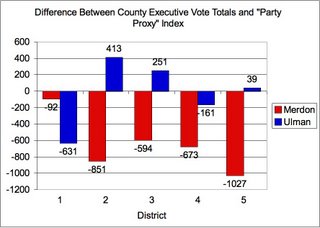With all but a few votes counted, the question now changes from “Who won?” to “Why?”
(Except for the District 1 council seat, which could still go either way depending on those pesky absentee ballots.)
I’m not of sufficiently clear mind to have thought the “Why” question through in any great detail, but others have taken a stab at it and provided several plausible and likely explanations.
First, the Washington Post’s story about the county executive race blames President Bush (typical MSM BDS and whatnot):
The 32-year-old wunderkind of Howard County Democratic politics yesterday became the youngest person elected county executive in Maryland in recent history, cresting to victory on a wave of opposition to President Bush and Congressional Republicans.
In a near Democratic sweep that secured the party's hold on the bellwether county, Ken Ulman defeated his colleague from the County Council, Republican Christopher J. Merdon, and the Democrats picked up a fourth seat on the five-member panel.
The major local issue was how to control the unrelenting growth in Howard. But many voters said yesterday that their primary motivation at the ballot box was animosity toward national GOP leaders.
"This is a message to George W. Bush," said Julie Pogach, 50, a consultant from Clarksville, describing her votes for every Democratic candidate on the ballot. "My anger at him and the Republicans trickles all the way down to the local races."
Voters yesterday said they still cared deeply about the impact of growth on Howard, the third-wealthiest county in the nation and the site of one of the region's best-rated school systems. They expressed concern that an influx of new residents, including many from a planned expansion at nearby Fort Meade, could begin to erode the quality of life in the county.
But many residents said the wonkish debates over growth were so intricate that they could not differentiate between the two candidates. Merdon, a 35-year-old businessman, portrayed himself as the slow-growth candidate and said on his campaign signs, "Vote Slow Growth!" Ulman, a lawyer, disputed his opponent's characterization and attacked him for doing little to control growth in his own council district.
"Everybody says, 'I'm slow growth, I'm slow growth,' but I really don't know who is or who isn't," said Jason Shapiro, 45, an attorney from Columbia. "Who knows what they'll do once they get into office?"
Certainly, the anti-Republican sentiment was strong this election, but the Post’s writer seems to throw all his eggs in this basket, which I think is a bit of a cop out. As for the growth debates being “wonkish” and “intricate,” hey man, that’s what blogs are for: making wonkish accessible and fun.
The other papers posted stories about this race but offered few details beyond “Ulman leading.” The blogs, however, have stepped up to fill the analysis void. Here's
Steve Fine:
Ken Ulman won (big) because:
It was a bad year to be a Republican.
The Ulman /O'Malley campaign did a fantastic job, except in the local free media.
The GOTV effort was superbly conceived and executed.
Ken was a much more substantive and sincere candidate.
Merdon's message was flawed: he had a number of pro-growth votes in his own record, while Ken lead the effort to save Meriweather and to create the Charette process.
The Growth issue didn't sway a lot of votes.
I agree with a few of those. First, the GOTV (Get Out The Vote, something I learned yesterday!) was impressive. I heard from several folks that they were disappointed with the lack of Democratic poll workers. Indeed, in my travels yesterday, the Republicans seemed to have numerous bodies at each poll, while the Democrats had significantly fewer.
Well, that is because many of the Democratic workers were out knocking on doors making sure their party-mates had voted. This is what I spent most of my day doing, and we actually had great responses from residents. How many additional voters were generated by this is hard to determine, but surely, it was more than zero.
The point about the dueling growth messages, on the other hand, only partially explains what was going on. Chris Merdon had his vote against Comp Lite as his centerpiece. Ulman had saving Merriweather. One could probably say something about the impact on voter psychology of an inherently negative message – “I’m against…” – versus a more positive message – “I saved…” – but I think that’s going too far.
Really, the success of the competing messages had more to do with the power of the symbols. Merdon voted against an arcane piece of zoning legislation that really upset a few people but failed to show up on the radar screens of most. Ulman saved Merriweather.
(Let’s not argue specifics here about what he did and did not do with respect to the fact that Merriweather remains open. Merdon never challenged this point, which I think says it all.)
Reports from several poll workers were that people did vote for Ulman because of his connection to Merriweather. Even my MoCo father met someone who said they were voting for Ulman because of Merriweather. To be sure, it is a much more powerful and understandable symbol than a zoning bill.
Meanwhile, Wordbones doesn't so much offer reasons for the way things happened as
lessons learned:
What messages do I get from the election results?
1) COPE was a big NOPE. Angela Beltram and her minions were less than advertised in influencing voters. Cooler heads prevailed.
2) Democrats for Merdon were a very small group. The only ones behind those individuals who stood beneath the people tree pledging their support to Chris were the gold plated figures on the people tree.
3) We may not now who represents District One until Thursday. Tony did better than many expected him to. This is the one race besides the Governors that could be decided by absentee ballots.
4) Being a member of the Colloseum Gym on Red Branch Road in Columbia continues to be good luck for county exec candidates. Chuck Ecker is a member, Jim Robey is a member and Ken Ulman is a member. Chris Merdon is not a member.
5) The people in Howard County are more informed than I thought. The strongest evidence of that was Allen Dyer failing to win a seat on the school board.
I especially like number 4 (note to self: get a membership). Obviously, Wordbones is having a little fun with some of these, at least I think it's obvious. But he touches on a valid point; namely, the impact of small but vocal constituencies.
Reading the blogs over the last few months likely left most convinced of Republican domination. With so many outspoken critics of the Democrats -- particularly Ulman -- it seemed their loses were foregone conclusions. Which, clearly, was not the case.
As I said in my
prediction post, I'm not very sanguine about the influence of blogs or local media in general. We touch only a very small portion of the electorate and the partisanship of cyberspace is considerably out of line with that of the county as a whole. We've created our own consuming reality, in a sense, which served to insulate us from more mainstream voters.
I don't mean to say the blogs are bad or anything like that. It's just that they skew our perspective considerably, something to keep in mind during the next election.
Finally, a few commenters on other blogs have floated the idea that the results of this election are a product of voter stupidity. This explanation deserves no more consideration than a mention. It is completely lacking in class and reason, and is more reflective of those who would resort to it than voters as a whole.
For better examples of how to deal with results that don't go your way, check out both
David Keelan's and
David Wissing's posts today. I'm sure they didn't want to write those posts as much as I didn't want to have to write one myself, but the fact that they did shows a lot about their character. You guys did great work.
Only three more years until the next election begins!








